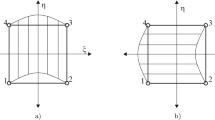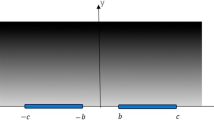Abstract
The mechanical model was established for the Dirac-type anti-plane transient fracture problem of the weak-discontinuous interface between two FGMs half-planes. Integral transform was adopted to derive Cauchy singular integral equation and Erdogan’s allocation method was used to calculate transient stress intensity factors numerically. The numerical solutions of the weak-discontinuous case were contrasted with those of the infinitesimal-discontinuous one. Two possible effective methods to diminish the peak values of transient stress intensity factors are discussed. One is to reduce the weak-discontinuity of the interface, i.e., to make the ratio of the two non-homogeneity parameters be close to 1.0 and to avoid the case that the signs of the two non-homogeneity parameters are different. Another is to make a compromise between the weak-discontinuity and the all-continuity, i.e., to make FGMs interface infinitesimal-discontinuous. Simple method was suggested for the realization of the infinitesimal-discontinuity of FGMs interface. From the strong-discontinuous interface to the weak- discontinuous one, and then to the infinitesimal-discontinuous one, this is a law and trend of the development of composite interfaces. To design and manufacture infinitesimal-discontinuous interfaces may be a brand-new effective approach to enhance the reliability of composite structures, and the first rank infinitesimal-discontinuity is enough to improve the mechanical performances of composites notably.
Similar content being viewed by others
References
Chen YF, Erdogan F (1996) The interface crack problem for a nonhomogeneous coating bonded to a homogeneous substrate. Mech Phys Solids 44:771–787
Delale F, Erdogan F (1988) On the mechanical modeling of the interfacial region in bonded half-planes. J Appl Mech 55:317–324
Erdogan F, Gupta GD (1972) On the numerical solution of singular integral equations. Q Appl Math 29(4):525–534
Guo LC, Wu LZ, Zeng T, Ma L (2004) The dynamic fracture behavior of a functionally graded coating–substrate system. Compos Struct 64:433–441
Huang GY, Wang YS, Dietmar G (2002) Fracture analysis of functionally graded coatings: antiplane deformation. Eur J Mech A/Solids 21:391–400
Huang GY, Wang YS, Gross D (2003) Fracture analysis of functionally graded coating: plane deformation. Euro J Mech A/Solids 22:535–544
Huang GY, Wang YS, Yu SW (2004) Fracture analysis of a functionally graded interfacial zone under plane deformation. Int J Solids Structures 41:731–743
** ZH, Noda N (1994) Crack-tip singular fields in nonhomogeneous materials. J Appl Mech 61(3): 738–740
** ZH, Batra RC (1996a) Some fracture mechanics concepts in functionally graded materials. J Mech Phys Solids 44(6):1221–1235
** ZH, Batra RC (1996b) Interface cracking between functionally graded coatings and a substrate under antiplane shear. Int J Eng Sci 34(13):1705–1716
Kim JH, Paulino GH (2002a) Finite element evaluation of mixed-mode stress intensity factor in functionally graded materials. Int J Numer Methods Eng 53(6):1903–1935
Kim JH, Paulino GH (2002b) Mixed-mode fracture of orthotropic functionally graded materials using finite elements and the modified crack closure method. Eng Fract Mech 69:1557–1586
Konda N, Erdogan F (1994) The mixed mode crack problem in a nonhomogeneous elastic medium. Eng Fract Mech 47:533–545
Li CY, Weng GJ (2001) Dynamic stress intensity factors of a cylindrical interface crack with a functionally graded interlayer. Mech Mater 33:325–333
Li YD, Jia B, Zhang N, Dai Y, Tang LQ (2006a) Anti-plane fracture analysis of functionally gradient material infinite strip with finite width. Appl Math Mech (Engl Ed) 27(6):773–780
Li YD, Jia B, Zhang N, Tang LQ, Dai Y (2006b) Dynamic stress intensity factor of the weak/infinitesimal-discontinuous interface crack of a FGM coating. Int J Solids Struct 43(16):4795–4809
Li YD, Zhang HC, Tan W (2006c) Fracture analysis of functionally gradient weak/micro-discontinuous interface with finite element method. Comput Mater Sci 38(2): 454–458
Lucia DC, Paolo V (2004) Finite elements for functionally graded Reissner-Mindlin plates. Comput Methods Appl Mech Eng 193(9–11):705–725
Miller MK, Guy WT (1966) Numerical inversion of the Laplace transform by use of Jacobi polynomials. J Numer Anal 3:624–635
Qian G, Nakamura T, Berndt CC, Leigh SH (1997) Tensile toughness test and high temperature fracture analysis of thermal barrier coatings. Acta Mater 45(4):1767–1784
Rice JR (1988) Elastic fracture mechanics concepts for interfacial cracks. J Appl Mech 55:98–103
Shaw LL (1998) Thermal residual stresses in plates and coatings composed of multi-layered and functionally graded materials. Compo Part B Eng 29(3): 199–210
Taher M, Saif A, Hui CY (1994) Plane strain asymptotic field of a crack growing along an elastic-elastic power law cree** bimaterial interface. J Mech Phys Solids 42(2):181–214
Tang LQ, Li YD, Liu CH (2004) Asymptotic analysis of mode II stationary growth crack on elastic-elastic power law cree** bimaterial interface. Appl Math Mech (Engl Ed)25(2):228–235
Wang BL, Mai YW, Sun YG (2003a) Anti-plane fracture of a functionally graded material strip. Euro J Mech A/Solids 22(3):357–368
Wang TC (1990) Elastic-Plastic asymptotic fields for cracks on bimaterial interfaces. Eng Fract Mech 37(3):527–538
Wang XY, Zou ZZ, Wang D (1997) On the penny-shaped crack in a nonhomogeneous interlayer of adjoining two different elastic materials. Int J Solids and Struct 34:3911–3921
Wang YS, Huang GY, Gross D (2003b) On the mechanical modeling of functionally graded interfacial zone with a Griffith crack: anti-plane deformation. J Appl Mech 70:676–680
Williams ML. (1959) The stress around a fault or crack in dissimilar media. Bull of Seismol Soc Am 49(2): 199–204
Zhao X, Meguid SA, Liew KM, (2002) The transient response of bonded piezoelectric and elastic half space with multiple interfacial collinear cracks. Acta Mech 159(1–4): 11–27
Author information
Authors and Affiliations
Corresponding author
Rights and permissions
About this article
Cite this article
Yongdong, L., Wei, T. & Hongcai, Z. Anti-plane transient fracture analysis of the functionally gradient elastic bi-material weak/infinitesimal-discontinuous interface. Int J Fract 142, 163–171 (2006). https://doi.org/10.1007/s10704-006-9041-6
Received:
Accepted:
Published:
Issue Date:
DOI: https://doi.org/10.1007/s10704-006-9041-6




